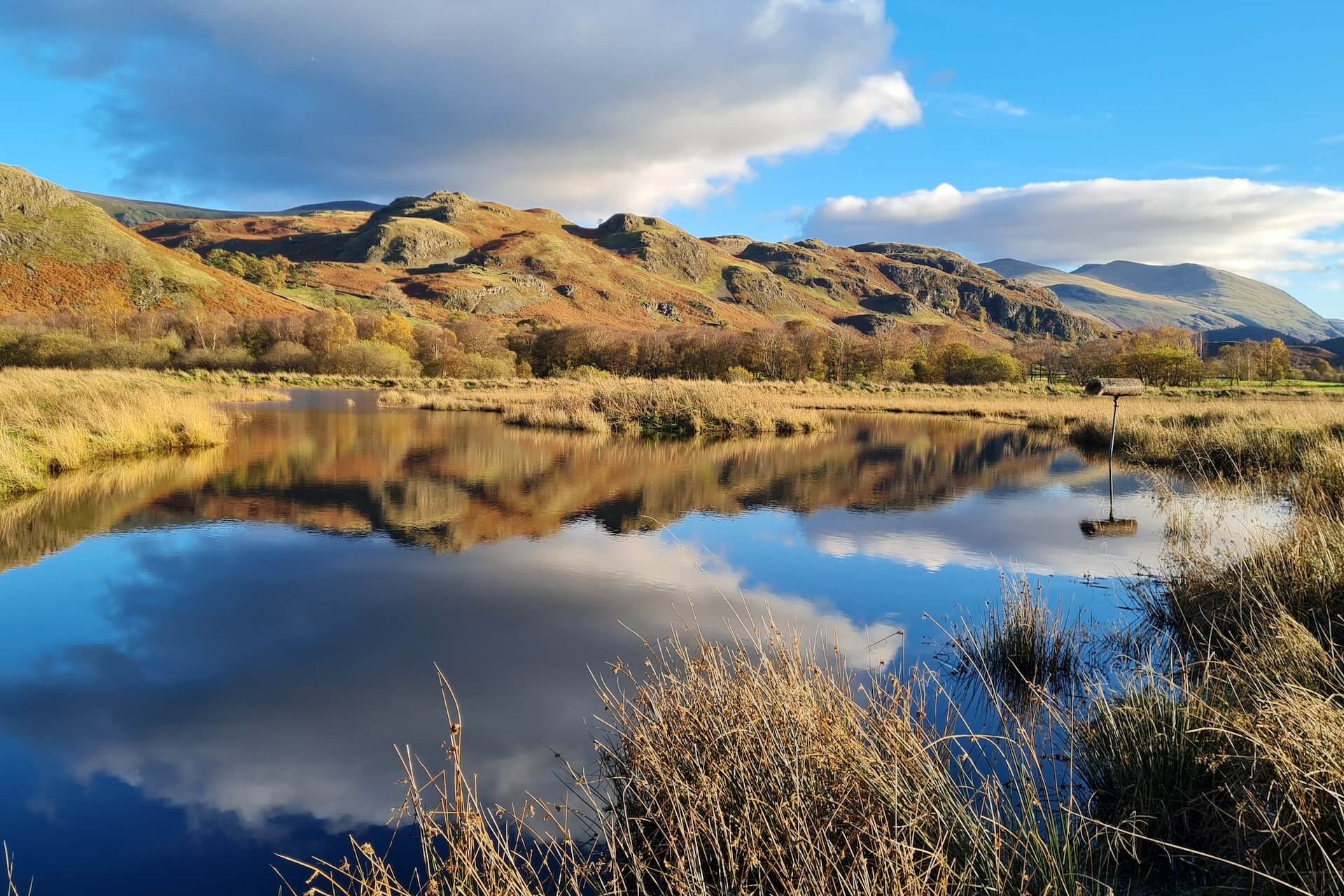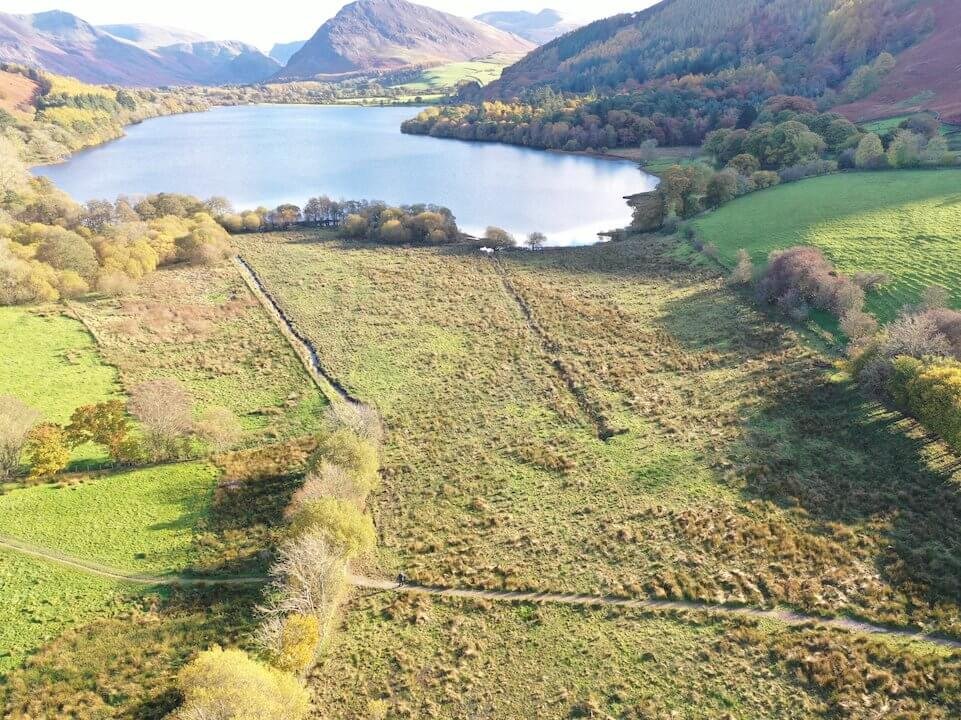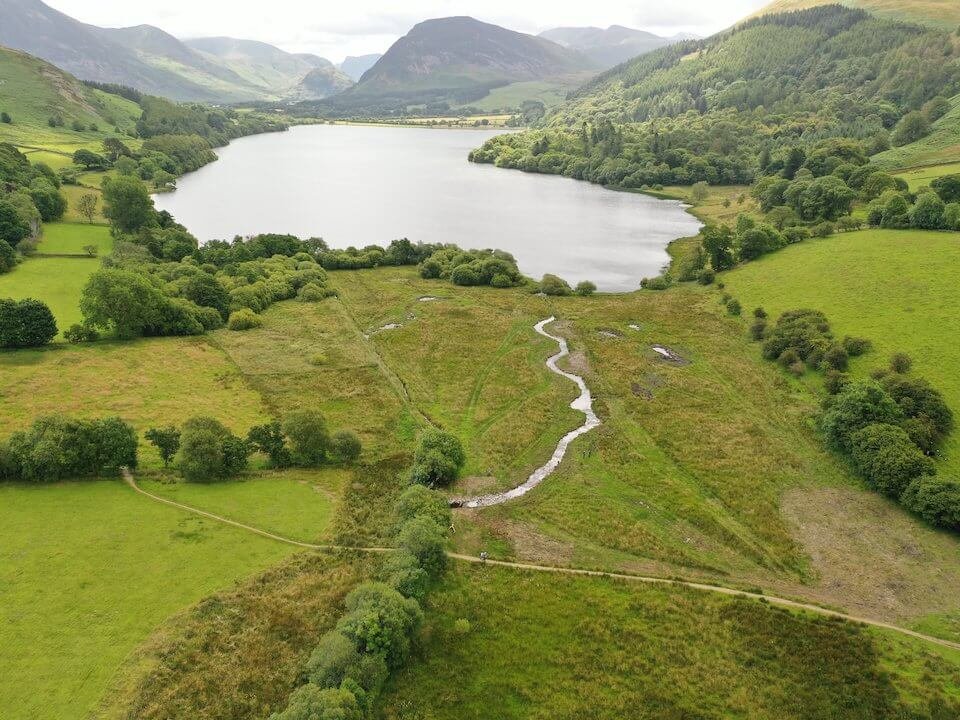
Natural Flood Management (NFM)
Flooding causes devastation to homes, businesses and communities. Although flooding is a natural process, the way we manage our landscapes has made flooding worse. Flooding is also predicted to significantly increase with climate change.
We can’t change the amount of rain that falls but we can change what happens to that rainwater once it’s in the landscape. Storing and slowing down water means the same amount of water travels through urban areas over a longer period of time. This reduces the intense peaks that cause flooding.
Natural Flood Management (NFM) involves restoring or mimicking natural processes to store water in the landscape or ‘slow the flow’ of water reaching the river channel to reduce flood risk downstream.
Flooding near Bassenthwaite Lake © Val Corbett
Dub Beck River Restoration

Before

After
How we do this
Soils
On roads, tarmac and buildings water can’t soak away and runs off the surface rapidly and into rivers. Rain falling on fields should be able to soak into the soil but most of our soils have been compacted by machinery or livestock. This reduces their ability to store water and causes water to runoff into watercourses very quickly.
What can we do?
Sustainable drainage systems catch water from roads and buildings and allow it to soak away slowly. Reducing compaction in soils allows more water to infiltrate into the soil. This improves soil structure for growing grass or crops, so it’s a win-win!
Trees
Trees can help reduce flooding in several ways. They intercept some rainfall with their leaves and send the water back into the atmosphere by evaporation, so it never reaches the ground.
For water that still reaches the ground, trees soak it up through their roots, helping to keep the soil dry and ready to absorb more water. Trees also slow down the flow of surface water. Over centuries, a lot of the woodland in England has been removed.
What can we do?
Planting more trees, woodlands and hedgerows can help reduce and manage flood risk, particularly across steep slopes or next to streams.
Rivers
Lots of our rivers have been straightened and dredged. This makes them shorter, steeper and smooth like canals so they transport water very quickly down to towns and villages. The energy of all this water moves gravels rapidly downstream, which can cause problems when it’s deposited under bridges and reduces their capacity.
What can we do?
Restoring wiggles in rivers makes the channel longer, so the water moves more slowly as it is taking a longer path. Reintroducing this natural function of rivers means it takes longer for the water to reach the town downstream which can help the river cope better with the volume of water. Wiggly rivers also catch more gravel so it doesn’t end up blocking up bridges.
Floodplains
The flat areas around a river are called floodplains. They are naturally meant to flood and store water but when embankments have been built, the river is no longer connected to the floodplain so all this water is forced downstream faster into urban areas.
What can we do?
Reconnecting rivers to their floodplains means water is stored on the land near the river rather than being forced downstream. We can also enhance the amount of water held on a floodplain by adding ‘bunds’ to store water. It then drains away slowly once the flood peak has passed.
Ponds and Wetlands
Peat bogs and wetlands are natural sponges but many have been drained or overgrazed and are no longer functioning as adequate water storage. There are also fewer ponds in the landscape than there used to be.
What can we do?
We can restore peat bogs by blocking man-made drainage ditches. This re-wets the bog, creating the right conditions for Sphagnum moss to grow and peat to form and soak up extra water. Building ponds that have extra capacity can allow water to be temporarily stored during flood events – this then drains away slowly after the flood peak has passed. By holding onto water, these features also make the landscape more resilient to droughts.
As well as reducing flood risk, all of these techniques have other benefits such as providing habitat, storing carbon or improving water quality. There are different ways of describing NFM, you may hear it referred to as ‘slowing the flow’, ‘working with natural processes’, ‘nature-based solutions’ or ‘upstream management’.
Natural Flood Management can be used alongside other methods of reducing flood risk such as engineered flood walls or floodgates for individual houses. Natural Flood Management is unlikely to prevent flooding, but it can help reduce the frequency or depth of floods.
See how catchment management can help us reduce the risk of flooding:
After
Before
Dovenby Bund holding back excess water after heavy rain.
Downloads
Download our NFM Handbook
Natural Flood Management Projects
River Cocker
Resilient Glenderamackin
Woodlands For Water

Support our work
Without the help of our fantastic supporters, we’d be up the creek!








